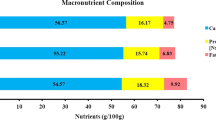Abstract
Pea (Pisum sativum L.), faba bean (Vicia faba L. spp. minor), and lentil (Lens culinaris Medik.) meals, protein concentrates and isolates were analyzed for proximate composition, oligosaccharides, and amino acid composition. Protein quality was evaluated using a mouse bio-assay. The concentrates contained 59.2 to 70.6% and the isolates 86.7 to 90.8% protein (N × 6.25) on moisture-free basis. Glucose, sucrose, raffinose, stachyose and verbascose were present in the highest concentrations in the protein concentrates (7.1 to 11.1%), the pea protein concentrate contained 8.7% sugars and faba bean and lentil protein concentrates 7.1% and 6.6% respectively. The protein isolates were almost free (containing less than 0.79%) of the sugars. Amino acid composition of the meals, concentrates and isolates showed, as expected, sulfur-amino acid deficiency (about two thirds of the rat requirement), which was probably largely responsible for the low protein efficiency ratios (0.75 to 1.18), and net protein ratios (0.25 to 0.73) of the three products, compared to values of 2.56 and 2.18 respectively obtained for casein. The protein digestibilities of the meals, concentrates and isolates (81 to 90%) were similar to that of casein (87%). The poor growth-promoting abilities of the meals, concentrates and isolates were possibly also due to growth-depressing factors such as tannins, trypsin inhibitors and hemagglutinins present, particularly in faba bean and lentil.
Similar content being viewed by others
References
Abu-Shakara S, S Tamnous RI (1977) Nutritional value and quality of lentils In: Webb C and Hawtin G (eds) Lentils, England: Commonwealth Agriculture Bureau, pp 191–202
Association of Official Analytical Chemists (AOAC) (1980) Official Methods of Analysis, 13th edn. Washington DC
Bhatty RS (1982) In vitro hydrolysis of skim milk and pea proteins by pepsin and rennin. Can Inst Food Sci Tech J 15:101–108
Bhatty RS, Christison GI (1980) Digestibity of pea proteins by preruminant calves. Can J Animal Sci 60:925–930
Bhatty RS, Slinkard AE, Sosulski FW (1976) Chemical composition and protein characteristics of lentils. Can J Plant Sci 56:787–794
Bell JM, Young CG (1970) Studies with mice on the nutritional value of pea protein concentrate. Can J Animal Sci 50:219–226
Bell JM, Wilson AG (1970) An evaluation of field peas as a protein and energy source for swine rations. Can J Animal Sci 50:15–23
Bell JM, Harvey BE, Christison GI (1979) Effects of the addition of enzyme and carboxymethylcellulose to pea flour used for calf milk replacers. Can J Animal Sci 59:43–50
Chiang BY, Johnson JA (1977) Measurement of total and gelatinized starch by glucoamylase and o-toluidine reagent. Cereal Chem 54:429-
Fan TY, Sosulski FW (1974) Dispersability and isolation of proteins from legume flours. Can Institute Food Sci Tech J 7:256–259
Fleming SE, Reichert RD (1983) A comparison of the flatulence potential of field pea and soybean seed fractions. Can Inst Food Sci Tech J 16:30–34
Hackler LR (1977) Methods of measuring protein quality: a review of bioassay procedures. Cereal Chem 54:984–995
Marquardt RR, Campbell LD, Stothers SC, McKirdy JA (1974) Growth responses of chicks and rats fed diets containing four cultivars of raw or autoclaved faba beans. Can J Animal Sci 54:177–182
Marquardt RR, McKirdy JA, Ward T, Campbell LD (1975) Amino acid, hemagglutinin and trypsin inhibitor levels, and proximate analysis of faba bean fractions. Can J Animal Sci 55:421–429
Marquardt RR, Ward AT, Cambell LD, Cansfield PE (1977) Purification, identification and characterization of a growth inhibitor in faba beans (Vicia faba L. var. minor). J Nutr 107:1313–1324
McDonald P, Edwards RA, Greenhalgh JFD (1973) Animal nutrition, second edition. Edinburgh: Oliver and Boyd
Murray ED, Myers CD, Barker LD (1978) Protein product and process for preparing same. Canadian Patient 1028552. Ottawa, Canada
National Research Council — National Academy of Sciences (1972) Nutrient requirements of Laboratory animals, second edition. Washington, DC: National Academy of sciences
Patel KM, Johnson JA (1974) Horse bean as protein supplement in bread-making 1. Isolation of horse bean protein and its amino acid composition. Cereal Chem 51: 693–701
Patel PR, Youngs CG, Grant DR (1981) Preparation and properties of spray-dried pea protein concentrate-cheese whey blends. Cereal Chem 58:249–255
Sarwar G, Sosulski FW, Bell JM (1975) Nutritive value of field pea and faba bean proteins in rat diets. Can Inst Food Sci Tech J 8:109–112
Sarwar G, Sosulski FW, Bell JM (1977) Availability of amino acids in legumes and legume-wheat blends. Can Inst Food Sci Tech J 10:31–35
Sosulski FW, Youngs CG (1979) Yield and functional properties of air-classified protein and starch frations from eight grain legume flours. J Am Oil Chem Soc 56:292–295
Sosulski FW, Elkowicz L, Riechert RD (1982) Oligosaccharides in eleven legumes and their air-classified protein and starch fractions. J Food Sci 47:498–502
Tyler RT, Youngs CG, Sosulski (1981) Air-classification of legumes. 1. Separation efficiency, yield, and composition of the starch and protein fractions. Cereal Chem 58:144–148
Vose JR, Basterrechea MJ, Gorin PA, Finlayson AJ, Youngs CG (1976) Air-classification of field peas and horse bean flours: chemical studies of starch and protein fractions. Cereal Chem 53:928–936
Author information
Authors and Affiliations
Rights and permissions
About this article
Cite this article
Bhatty, R.S., Christison, G.I. Composition and nutritional quality of pea (Pisum sativum L.), faba bean (Vicia faba L. spp. minor) and lentil (Lens culinaris Medik.) meals, protein concentrates and isolates. Plant Food Hum Nutr 34, 41–51 (1984). https://doi.org/10.1007/BF01095071
Received:
Revised:
Issue Date:
DOI: https://doi.org/10.1007/BF01095071



